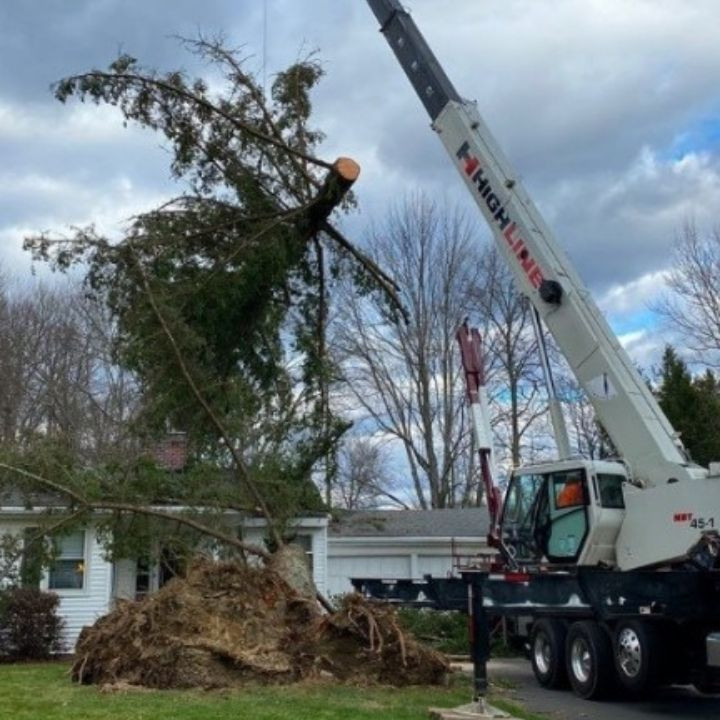What is the Best Way to Care for a Damaged Tree?
The winter snow and ice can wreak havoc on trees and other landscaping surrounding your property. In the northeast region of CT, every winter, broken branches, and split and leaning trees are frequent. Your trees can get back to health in the springtime, even though you cannot predict the weather.
What can you do to bring back plants after the winter?
Here are some tips from Tree Service CT professionals to assess the damage to trees and then clean up after winter.
SNOWSTORM POST-SNOWSTORM, BE AWARE OF RIS Situations FIRST
If you find fallen electrical wires, avoid them! If you see any, do not contact your utility company. Broken or fallen power lines or entangled tree branches must be addressed immediately following an event.
Then, look for tree limbs reaching over your house, driveway, or other structures. The safety issues should be addressed immediately by tree maintenance CT.
Call your municipality's public works department for a non-life threatening emergency to report any limbs or trees blocking the road or walkway.
CHECK YOUR TREES FOR DAMAGE
After a winter storm or large snowfalls, it is crucial to examine your trees. This inspection should be carried out towards the end of winter to ensure your trees are protected and ready for spring. With the additional weight of the spring foliage, any structural weaknesses in your trees are likely to be more obvious (potentially dangerous).
What to look for after a winter storm and before spring:
- A limb that is swinging (these can fall at any time, so be aware of any trees with hanging branches)
- Broken
- Snarl
- The bending of trees by snow or ice and branches
- A split tree (this is commonplace in Bradford pears and multi-stemmed trees)
- Any signs of a tree drooping or a tree leaning
- The leader was smashed or (the main upward branch).
- Damaged cabling (these are difficult to identify without a thorough examination).
- The limbs may be cracked or split (these may not be obvious from the ground).
- Invisible damage (like fallen limbs cluttering your lawn) could be possible. There's a chance of hidden damage if you see winter storm destruction to your trees. If you notice winter storm tree damage, there could be hidden damages.
SALT BURN SIGNS BEFORE SPRING
If your trees are close to a highway, they may have been treated with salt. The salt melts from snow will cause soil erosion, exposing trees close to sidewalks and driveways covered with snow.
The defense mechanisms that shield trees from salt damage are lacking. Check for signs of damage from salt in the spring and throughout the growing season; certain damage won't be visible until later.
Winter salt damage symptoms include:
- Dying needles, evergreen leaves, and needles
- It is most common in winter when trees are exposed to salt sprays by nearby roads. The trees lose their leaves or needles, and their branches are stripped.
- Salt damage can be identified through the appearance of decayed branches and twigs on deciduous trees.
- Salt damage is an everyday occurrence in the northeast of CT during winter. There are methods to safeguard your trees, shrubs, and perennials.
Learn how to protect trees from damage caused by salt
Check the Condition of your Tree
Examining your tree's health and the damage it has suffered from storms is essential. The fast-growing shade trees such as elms and silver maples, birches, and willows have brittle wood that is easily broken. Even crotch unions with weaker strength are easily broken, just like those found on Bradford pears.
Often, severely damaged trees suffer from significant decay and rot that homeowners may not be able to see. It's easier and less expensive to address a tree's issues before damage occurs than to "fix" or get rid of it later.
REALISTIC ADVICE ABOUT DIY REPAIRS
Tree damage can be invisible from the ground. However, it's not the only way to see it. Winter storms may split or break limbs in the treetops, posing a risk during future powerful wind storms.
Do not use ladders when working with a chainsaw or any other equipment. Find local and trustworthy tree services in CT. That's where Spear Bro's Tree Care Service comes in. We are a local-owned Tree service CT company that offers affordable and reliable tree removal, stump grinding, tree trimming, and pruning services. Our customers are delighted with our simple approach and high-quality work. Spear Bros Tree Service can help you with the removal of trees in Connecticut, whether you require it for one tree or for commercial or large-scale residential projects. Contact us today for a free estimate.
Spear Bro’s Tree Service
1495 Wolcott Road, Wolcott, CT, 06716
860-321-8499
https://spearbrostreeservicect.com
https://www.google.com/maps?cid=17050630439033990533
https://www.google.com/search?q=Spear+Bro%E2%80%99s+Tree+Service&kponly&kgmid=/g/11q4dl1c_f
https://search.google.com/local/writereview?placeid=ChIJo7UbaYy554kRhW0V0wsCoOw
https://www.facebook.com/SpearBrosTree
https://www.instagram.com/spearbros_treeservice/
https://www.youtube.com/channel/UCnHtJPzz4eT7WDJfmbgfjgA

